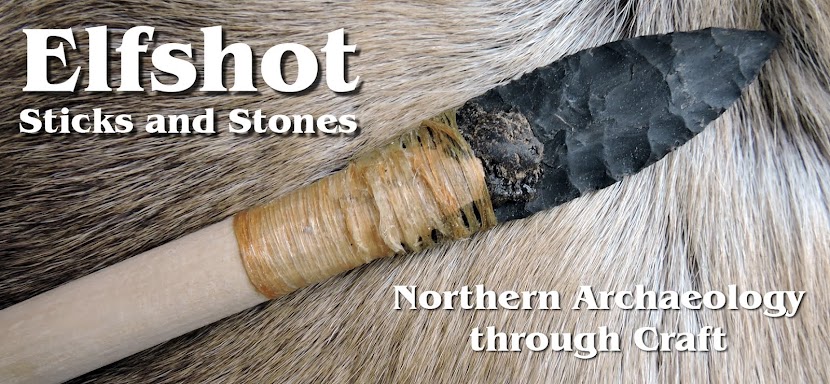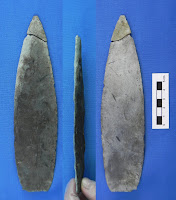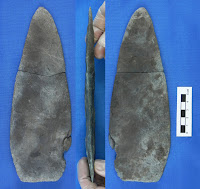 |
| Change Islands Cache Bifaces |
Late last summer, a Newfoundland and Labrador couple stretching their legs at the Change Islands ferry terminal unexpectedly made a spectacular archaeological find. In September 2010, Neil White and Marion Adams discovered a tighly packed cache of 32 large rhyolite bifaces. The stone artifacts were buried standing on edge stacked together "like a deck of cards". A few biface fragments were on the surface and caught Neil's eye. He recognized that the stones were flinknapped from watching survival TV programs. The tip of one of the points had been exposed on the surface long enough that it was spattered with paint from nearby construction. A backhoe used in the construction had stripped several inches of debris and soil over the cache and when the White's found them they were very near the surface. Not realizing the size of the cache, the White's pulled the bifaces out of the ground one after the other. As they slid each one out of the ground they could hear it rasping against another one still
in situ.
 |
| Beautifully worked rhyolite |
Neil and Marion immediately recognized the significance of what they had found and they didn't want to disturb the whole cache, but they were worried about its security if it was left partially exposed. Neil said that the entire cache came from an area in the ground no bigger than an apple crate. Originally, the bifaces may have been wrapped together in a leather or bark bundle, or buried in a small hole. They decided to gather up the bifaces and contact an archaeologist. They took the bifaces to the nearest museum - the Beothuk Interpretation Centre in Boyd's Cove. Karen Ledrew-Day knew that this was something very special and contacted the Provincial Archaeology Office (PAO). Ken Reynolds drove out to the Change Island's to meet the Whites, further excavate the findspot, and collect the bifaces. Perhaps the most noteworthy aspect of the whole story is the selflessness of Neil White and Marion Adams, whose first thought was to report their find and donate the artifacts to the people of the Province. They deserve a lot of credit for how they reported the find.
 |
| An awe inspiring visit |
Lori and I had the opportunity to see and photograph the bifaces when Ken brought them back to the PAO for cataloguing and analysis. We've been waiting for the Minister of Tourism, Culture and Recreation to publicly acknowledge the White's find before we mentioned the cache here. Disappointingly, that never happened, but the cache was reported in the Provincial Archaeology Office's annual archaeology review earlier this week (
Volume 9 for 2010 Field Season), so Lori and I can now share our photos of the bifaces.
 |
| For their size, they are very thin |
Although they vary in size and 4 of them are wide flat platters, the 32 bifaces are remarkably uniform in style. They are all made from the same material and are equally thin and well finished. Everyone who sees them feels that they were all made by one person. There are some breaks, but between the White's initial collection and Ken's subsequent excavation of the findspot, many of the missing tips and corners were found. It appears that the bifaces were perfect, whole, and unused when they were originally cached. These are not preforms in the midst of transport, or blanks prepared for heat treatment, but completed tools, that were never used. If the larger bifaces were bifacial cores, then they were used up and the edges carefully finished.
 |
| The cache at the PAO |
The exact age of the cache is uncertain and will be the subject of future research, however, there are a couple likely candidates. The Maritime Archaic Indians and Recent Indians both made large bifaces from Rhyolite and could have left the cache. Given the location of the find very close to the modern shoreline, I feel that the Recent Indians are the more likely candidates. The shoreline in this part of Newfoundland has undergone several metres of submergence since Maritime Archaic Indian times, which means that an Archaic cache at this spot would likely be underwater, unless it was placed at an unusually high elevation. If it is a Recent Indian cache, then the earlier Cow Head or perhaps Beaches complexes (ca. 2000-1000 BP) seem more likely than the Little Passage or Beothuk, because such large stone tools are rare in the more recent periods.
 |
| Some were very large |
The source of the stone will also be more fully researched as there are several rhyolite outcrops and quarries on the Island that might have provided the stone. When Ken was in the area, he revisited the Rhyolite outcrops and workshops at Brimstone Head, near Fogo and collected samples that are a very good visual match for the artifacts in the cache. Its the closest known rhyolite source to the cache and seems like the most likely candidate for the rock. Researchers at Memorial University of Newfoundland are doing
non-destructive testing on the bifaces to attempt to determine the source of the raw material.
 |
| The Change Islands Cache (click to enlarge) |
For more information on the Change Island's Cache - check out the
Provincial Archaeology Office's Archaeology Review,
Volume 9 for 2010 Field Season, pg 137-140.
Here are the photos of the 32 bifaces that Lori and I took last fall. You can click any of the images to see a larger version. Thanks to the PAO for letting us see these unique pieces and especially to Neil White and Marion Adams for sharing this amazing find with the all the people of Newfoundland and Labrador.









 Photo Credits:
Photo Credits: Tim Rast
Edited April 6, 2011 to correct Marion's name.













































































